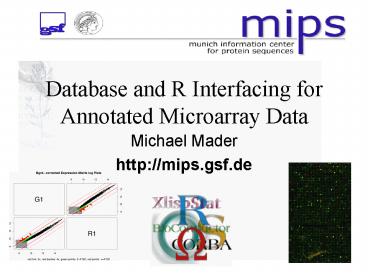Database and R Interfacing for Annotated Microarray Data - PowerPoint PPT Presentation
1 / 25
Title:
Database and R Interfacing for Annotated Microarray Data
Description:
public central databases like GEO and ArrayExpress ... Acknowledgements. Alexey Antonov. Jan Budczies. Matthias Oesterheld. Sabine Tornow. Werner Mewes ... – PowerPoint PPT presentation
Number of Views:34
Avg rating:3.0/5.0
Title: Database and R Interfacing for Annotated Microarray Data
1
Database and R Interfacing for Annotated
Microarray Data
- Michael Mader
- http//mips.gsf.de
2
Microarray data management
- public central databases like GEO and
ArrayExpress - open-source distributed management systems (SMD,
TM4) - repositories with mining capabilities,
comprehensive annotation and (www-)statistics
(GeneX, ...)
3
ME - System Architecture
Graphics/ statistics
(Re-)annotation system
Data retrieval
Upload interface
Authentication module
R statistical engine
Interfaces
DB/ Oracle
CORBA, bioMoby,.
Interfaces
4
ME DB structure
- Oracle or DB2 (transaction control)
- Entity-Attribute-Value systems in grey
Biomaterial
Core Data
Arrays
Element anno
Simplified schema, 45 tables element anno system
5
Interface Requirements
- fast (time does matter for online appl.)
- flexible
- transparent
- handling EAV-systems
- fast even with complex SQL statements
6
Queries and analysis pipelines
7
Queries and analysis pipelines
- Simple ones by biologists and medical staff
without statistical background (level 1 users)
8
Queries and analysis pipelines
- Simple ones by biologists and medical staff
without statistical background (level 1 users) - Advanced pipelines by lab researchers with
statistical background (level 2 users)
9
Queries and analysis pipelines
- Simple ones by biologists and medical staff
without statistical background (level 1 users) - Advanced pipelines by lab researchers with
statistical background (level 2 users) - Sophisticated queues by bioinformaticians and
statisticians (level 3 users)
10
Analyis pipelines II
run-time contributions on small local DB server,
ROracle/Rdbi as interface
11
Analysis pipelines III
- Level 1 tasks/users are extremely frequent in
microarray repositories - Data retrieval has considerable impact
- Is ROracle/Rdbi the best choice for this?
12
The prepare issue
13
The prepare issue
- Oracle prepares are good if they are rare
(cost-based optimizer)
14
The prepare issue
- Oracle prepares are good if they are rare
(cost-based optimizer) - repeated prepares are still OK if there is
nothing to optimize (primitive SQL)
15
The prepare issue
- Oracle prepares are good if they are rare
(cost-based optimizer) - repeated prepares are still OK if there is
nothing to optimize (primitive SQL) - repeated prepares are even OK if you stick to the
rule-based optimizer
16
The prepare issue
- Oracle prepares are good if they are rare
(cost-based optimizer) - repeated prepares are still OK if there is
nothing to optimize (primitive SQL) - repeated prepares are even OK if you stick to the
rule-based optimizer - repeated prepares are vasted time in mining-like
SQL queries (cost-based optimizer, complex SQL)
17
Status
- Data retrieval has considerable impact,
especially for the common level 1 tasks - repeated prepares (ROracle) dont scale
- retrieval from EAV-systems turns out to be
difficult and consumptive
18
OTL
- open-source template library
- implements large-parts of OCI
- high-level DB interface programming
- for Oracle, DB2, ODBC, ...
- by Sergei Kuchinhttp//otl.sourceforge.net
19
OTL implementation
- using SQL binds and stream directly into STL
vector-based objects - separated handling of expression data (relational
data) and annotation (EAV data, DB-links, ...)
20
OTL simplistic example
21
OTL simplistic example
- vectorltfloatgt select(int idl)
- otl_stream i(1000, /buffer size/
- "SELECT val,bkg FROM expr.data WHERE
f_key varltintgt", - db)
- float val, bkg
- vectorltfloatgt v
- iltltidl / bind variable/
- while(!i.eof())
- igtgtvalgtgtbkg
- v.push_back(val - bkg)
- return v
22
Performance
- much faster as RefCursor (PL/SQL) approach (on
small local DB servers) - OTL-based interface is 40 faster than ROracle
for typical microarray data (20,000100 10
anno values) - memory consumption is at least 20 lower (but not
an issue) - no excessive type checking needing in the R code
23
Future Developments
- bidirectional interface for R result objects
- generalization of the interface and public
open-source release - Mining on C level (no problems with excessively
large data objects in R)? - switch from HTML to XML on output level
24
Summary
- fast and flexible user-transparent interface
needed in bioinformatics - higher performance due to bindings might be
crucial - restructuring data heterogeneous data in C can
be faster and less memory consumptive - OTL offers nice opportunities for
vector/matrix-oriented retrieval
25
Acknowledgements
- Alexey Antonov
- Jan Budczies
- Matthias Oesterheld
- Sabine Tornow
- Werner Mewes































